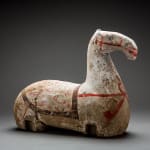Han Polychrome Torso of a Horse, 206 BCE - 220 CE
Terracotta
height 34.3 cm
height 13 1/2 in
height 13 1/2 in
H.501
This powerfully modeled torso o a horse is painted with a full harness in red and white pigment. The saddle is outlined in blue paint and decorated with red circula...
This powerfully modeled torso o a horse is painted with a full harness in red and white pigment. The saddle is outlined in blue paint and decorated with red circula designs. Staring eyes, bared teet and flared nostrils, the horse's expression is full of ferocity. With its ear pulled back, ridge of the nose sharply angled, and chest thrusting forward, w can imagine this horse magnificently galloping into battle, determined as is hi rider, to triumph and conquer.
The legendary "heavenly horses" of the West intrigued the Han emperor wh set out on a mission to obtain these gallant horses that, according to legend,
sweat blood. The horse became symbol of military prowess, strength, and vitality. It was at the foundation upon which rests the army. Along the roads to the imperial tombs of the Han dynasty, recreations o horse in ceramic were placed to fortify the entrance as were recreations o chariots, riders and thousands of foot soldiers. This thirst for immortality is what brought about this elaborate buria custom for it was believed that the deceased needed to be protected in thei journey to paradise.
The legendary "heavenly horses" of the West intrigued the Han emperor wh set out on a mission to obtain these gallant horses that, according to legend,
sweat blood. The horse became symbol of military prowess, strength, and vitality. It was at the foundation upon which rests the army. Along the roads to the imperial tombs of the Han dynasty, recreations o horse in ceramic were placed to fortify the entrance as were recreations o chariots, riders and thousands of foot soldiers. This thirst for immortality is what brought about this elaborate buria custom for it was believed that the deceased needed to be protected in thei journey to paradise.
Provenance
The antiquity of this artefact was tested with Thermolumiscence by Oxford Authentication LTD. The certificate is provided upon acquisition.Literature
V17



